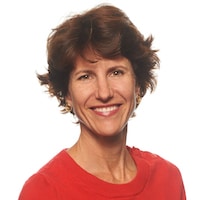Blended Finance Gets a $500 Million Boost: Convergence CEO Discusses Groundbreaking Partnership with IFC
US $2.5 trillion: That’s the estimated funding gap the world needs to close in order to achieve the Sustainable Development Goals. To achieve this daunting goal, says Convergence CEO Joan Larrea, “We need to tap into new sources of capital, particularly from private investors” – a goal Convergence advances by connecting, educating and supporting investors to execute blended finance transactions. By linking investors with the public and philanthropic parties that can help make a project or deal happen, it enables investments that would otherwise receive little or no interest from the private sector.
This approach recently got a half billion dollar shot in the arm, through a new platform Convergence is developing with IFC to support blended finance in health and education businesses in developing countries. Larrea discusses the partnership, which she calls “among the most prominent developments in the blended finance space to-date,” in this email Q&A.
JM: What makes Convergence unique in the impact investing space, and why do you see blended finance as a particularly effective approach?

Joan Larrea
JL: We see blended finance as occupying a distinct space from impact investing, although we see both playing key roles in achieving the SDGs. It is unique from impact investing in that a blended finance transaction does not require all investors to be impact or socially motivated to participate. In fact, to leverage the large amounts of money needed to accomplish the SDGs, we need to be creating structures that appeal to investors seeking full risk-adjusted returns. Blended finance is effective in the sense that it enables each public or philanthropic dollar to go further than it would on its own. For instance, for each $1 from a donor (e.g. aid agency, foundation), you may attract $5 from the private sector, given the improved risk-return profile attributed to the donor taking a first-loss position in a deal, or by providing a risk-sharing instrument like a guarantee.
Convergence is unique because we are the only institution in the world focusing exclusively on blended finance. We mobilize large-scale private capital into development, with the aim of closing the SDG funding gap, through a three-pronged approach:
- Design Funding – Providing grant support to early-stage blended finance vehicles, including a recent grant to structure and launch a Syrian refugee employment impact bond.
- The Investment Network – A matchmaking platform connecting public, private, and philanthropic investors with blended finance deals. We currently have over 150 registered institutions representing the private, public and philanthropic sectors, and deals seeking, in aggregate, over US$1 billion on the platform.
- Market Building Tools – Creating and compiling research and lessons learned on blended finance. We have built the most comprehensive historical blended finance deal database in the market (profiling over 200 transactions), and released landmark reports, such as The State of Blended Finance, and our work with the Brookings Institution on impact bonds in developing countries.
JM: Talk about the new platform you’re developing with IFC for blended finance in health and education businesses in developing countries. Why did you decide to focus on the health and education sectors, and what are the selection criteria for those businesses?
JL: In a world where inequality is rampant, many people lack basic access to health and education services and products. The base of the pyramid (BoP), or the world’s poorest population, face enormous barriers when it comes to health services and struggle to obtain educational opportunities—primary, secondary, tertiary or vocational—to pull themselves out of poverty.
In developing countries, the private sector provides an estimated 50 percent of health care and 20 percent of education services. Today, IFC has over US$2.5 billion in its health and education portfolio, however, IFC’s health and education program has primarily served what IFC refers to as “ the forgotten middle to lower middle class.” The platform is meant to complement IFC’s mainstream products, in order to finance riskier businesses that they normally would not be able to support, and help these businesses become financially sustainable and scalable. The selection criteria for these businesses are still being developed, but the following are being considered:
- Well-established businesses already serving the BoP or who aim to serve the BoP.
- Businesses serving the BoP that are financially sustainable and are too small for IFC today, but have potential to scale under the right conditions.
- Businesses serving the BoP that are not financially sustainable yet, but have a clear pathway to sustainability.
JM: What makes this platform so significant, for Convergence, the IFC and the sectors you’re investing in – and are there similar, existing models from which you’ll learn?
JL: First, it will be among the most prominent developments in the blended finance space to-date, raising up to US $500 million for health and education investments targeting the BoP, and will be a key tool in achieving the health and education related SDGs. Second, the platform will leverage the World Bank Group’s new US$2.5 billion International Development Association (IDA) Private Sector Window, which aims to catalyze private sector investment in IDA countries. Finally, for IFC, expanding access to health and education services is a central element of the World Bank Group’s strategy to eliminate poverty and reduce inequality. The platform will help IFC reach their ambitious targets by backing high-risk projects in the health and education sectors to make a significant impact in underserved markets in both IDA and non-IDA countries.
There currently aren’t any holistic and global platforms for health and education investments in developing countries, nor are there many platforms of comparable magnitude. Existing models have primarily been small scale investment funds or social enterprises specific to certain geographies and/or not focused on the BoP.
JM: Talk about the development potential of this project – what will success look like, and what are the biggest obstacles it’s likely to face?
JL: Success would be reaching the world’s poorest – the 4.5 billion people who live on less than US $8 per day, who are considered as the BoP – with funding from IFC and other investors to support riskier projects with potential for expanding access to quality, affordable health and education services.
The biggest obstacles would be doing transactions that fall outside IFC’s normal course of business, finalizing the platform’s design and offerings to ensure maximum impact for those who need it most, and to have successfully completed fundraising and implementation of the platform for it be operational by the end of 2018.
JM: How will Convergence and IFC go about raising the funds you’re aspiring to raise – what makes you confident the demand is there?
JL: Funding sources will include the IDA Private Sector Window, where an amount has been earmarked for the health and education sectors. IFC is the largest investor (debt and equity) in the private health and education sectors in developing countries, with total investments exceeding US $4.5 billion spread throughout 320 projects in over 62 countries; it brings an extensive network of like-minded investors, partners and participants to the table, who will be key fundraising targets. To complement this, Convergence will assist with fundraising and marketing efforts by i) reaching out to potential investors through our Investment Network platform, ii) leveraging our extensive network in the space, and iii) co-organizing workshops and summits to convene key potential stakeholders from the public, private and philanthropic sectors.
Convergence and IFC recently conducted an ecosystem analysis of the investing landscape to assess demand and market gaps to ensure that the Platform’s future design matches the institutional appetite of the target investors and donors.
JM: What impact do you expect this platform to have on reaching the Sustainable Development Goals, and how big a factor have they been in creating/designing the platform (and in Convergence’s broader work)?
JL: We expect the platform to have a significant impact on reaching the SDGs. Raising up to US $500 million for health and education has the potential to translate into billions of dollars worth of impact. What’s interesting is that blended finance allows Development Finance Institutions (DFIs), like IFC, to be more catalytic – by taking on more risk – than they normally would to attract private players into development, who otherwise wouldn’t participate.
The SDGs have played a central role in the creation and design of the platform for both IFC and Convergence. We envision the platform to be the marquee global vehicle to meet Goal 3 (Good Health and Wellbeing) and Goal 4 (Quality Education), by supporting high-risk projects with strong impact potential. IFC will not only leverage its own balance sheet, but will pool capital from partner organizations to achieve the greatest impact to meet the SDGs. The platform is still in the early stages of design, but we are considering supporting businesses that address (non-exhaustive): job skills development, financing schemes for students (especially girls), primary care for non-communicable diseases, and eye care to fight blindness. Together, Convergence and IFC have a strong fit of vision and will leverage each other to make the platform a success.
JM: One of the platform’s goals is to enable investors to support riskier projects – how much risk are we talking about, and how will you motivate investors to tackle it?
JL: The platform is intended to be a holistic one-stop shop that will cater to a wide range of investor profiles and address a range of funding needs. It is different in its design from existing models in its global focus and ability to attract both niche and generalist investors, and channel these funds into high-impact projects to reach the BoP. The platform’s structure is still being explored, but can take on a variety of forms such as housing one or two funds, or multiple funds with each targeting different risk appetites and overall returns. For instance, it may include i) a debt fund targeting high risk, early-stage businesses, ii) a debt fund targeting less risky, mature businesses, iii) an equity fund to provide patient capital and iv) a technical assistance fund to help with capacity building. Each of these funds would target different investor types and offer varying risk-returns profiles, and would comprise a blended finance structure that includes donors, foundations, DFIs and private commercial investors.
JM: You have referred to Convergence as a “Match.com for deals.” Please explain what this means – and say whether the new platform will operate in the same manner.
JL: Convergence’s Investment Network is our online platform for blended finance deals. Convergence does not participate in any of the transactions on our site. Instead, our aim is to provide a marketplace for blended finance deals, to ease transaction and searching costs for investors looking for credible deals in developing countries. When an institution registers on the Network as an investor they are automatically matched with deals based on their sector and geographic preferences, at which point they can start a confidential and direct conversation with the deal sponsor. Each deal undergoes due diligence, and must meet requirements such as having an anchor investor and being at least US $5 million in size.
The new platform will be an IFC in-house offering to draw co-investors into a wide range of investment opportunities that serve the BoP and would not otherwise happen due to prevailing market return expectations. IFC itself would be an investor in the transactions flowing through the IFC Platform. The technical details of how the platform will operate remain to be developed, but the partnership between Convergence and IFC will be leveraged for knowledge sharing and matchmaking opportunities between the two organizations due to the extensive institutional investor networks on both sides. And Convergence would be pleased to list on its Investment Network those blended finance deals generated inside the IFC Platform, to invite additional interest.
James Militzer is the editor of NextBillion.net.
- Categories
- Health Care, Investing



